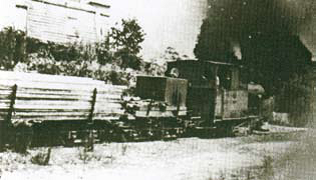

Colonial surveyor James Scott and his party completed a circuit of the area between the St Patricks River and the coast in 1852 and was impressed the fertility of what soon came to be known as “Scott’s new country”.
The catalyst to open more of the country came with mineral discoveries – tin in the east in 1873 and gold at Lisle in the western part of the region in 1879.
The consequent mines had an appetite for the timber which was in the way of agricultural expansion.
The arrival of the railway from Launceston to Scottsdale in 1889 created a link for timber-getters to market their product and sawmills started to spring up in the Sidling range district.
As the timber resource retreated from the proximity of the railway itself, the millers built tramways, bullock or horse-drawn, to connect to the main rail line.

Hudson’s Lisle sawmill c 1920. Photo courtesy of Greg Dickens
The mills cut timber common to their locale – generally Eucalyptus Regnans and Eucalyptus Delegatensis, favoured species for solid wood production still today.
An exception was George Peddle’s mills which starting at Nabowla and later at Legerwood specialised in myrtle and blackwood. The latter species particularly became famous through furniture production.
In fact Mr Peddle’s proficient furniture-making was rewarded with a contract to supply the train station waiting room chairs for the State railways and his rustic dining chairs remain a favourite in antique shops, if they can be found.

George Peddle’s sawmill, Lisle Road Nabowla Photo courtesy Jeff Edwards
The next concentration of forestry interest after the Sideling Range was the foothills of Mount Horror to the North East of Scottsdale.
Demand for timber for tin mines around Branxholm had already led to some harvesting at Warrentinna when the Closer Settlement Board launched a scheme to encourage settlement at the new township of Forester in 1908 and a repeated scheme in 1911.
Luckily for the settlers, who took up barely sustainable subsistence plots, these schemes coincided with the formation of the Tasmanian Timber and Tramway Company and construction of a sawmill at Pearly Brook and a tramway to Bridport in 1912-13.


A Tasmanian Timber Co’s loco nears Bridport and the new jetty c1913-14Photos courtesy Jeff Jennings
A new jetty was built at Bridport to cater for the timber exports via a small fleet of trading ketches. Timber from Mt Horror helped build the burgeoning suburbs of Melbourne and sleepers found their way as far as the railways of South Africa and China.
The Tasmanian Timber Company had been granted an extensive timber lease in the area and while it lived up to its ambition to process wood from the private blocks, it seemed to pay less attention to the forest in its leasehold which was cancelled in 1928 and what had been the biggest mill in the State was abandoned.
However, much of the milling and tramway equipment was acquired and moved a few miles south east after Henry Jones & Co examined the stands of timber on the slopes of Mount Horror and applied for an exclusive permit in late 1932. Suffering through the depression, the Government quickly approved the investment.
The new mill at Gellibrand dominated operations in the Mount Horror State forest from 1933 till 1945 when it was also abandoned in favour of a new site at Camden.

Mill workers at Henry Jones & Co’s Gellibrand Plains sawmill.Photo courtesy of Jeff Jennings.
Throughout the periods of dominance by Tasmanian Timber Co. and Henry Jones a number of smaller family owned mills worked the fringes of the big Mount Horror leases. These included James Gofton, J & I Gunn, Counsel Bros and A W Loone.
In 1945, the Forester Sawmilling Company established another new mill at the former Forester township and proceeded to log part of the original big lease that had been largely left untouched. This enterprise remained the principal forest user until 1952 when its Exclusive Forest Permit was cancelled and the mill abandoned.
Throughout the logging activity the Forestry Department established pine plantation on some of the now vacant forest around Warrentinna. They became the initiator for the softwood milling industry which helped sustain the North East up until 2011 when the second of two large mills at Scottsdale closed.

An old steam boiler… just part of the industrial archaeology still evident in the North East bush Photo Jeff Jennings













First Saturday of every month undercover in the CWA Hall, Main Street, Bridport (near the Village Green) Fresh produce, art, craft, bric-a-brac.
Discover more… + MAPHeld on the fourth Sunday of every month. A variety of stalls.
Discover more… + MAP